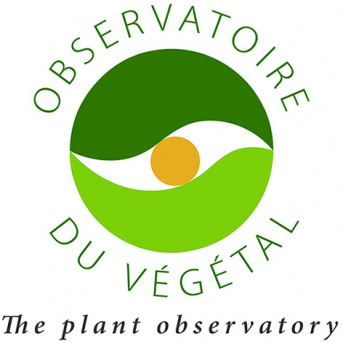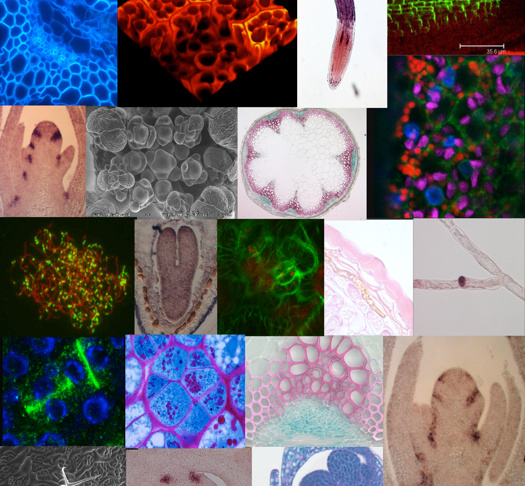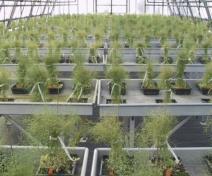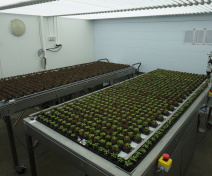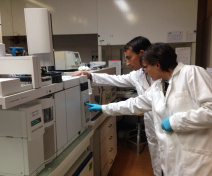The Plant Observatory (PO) is a large and unique cluster of integrated facilities dedicated to multi-level phenotyping of plants.
Biological question
Our goal is to achieve an integrated and high-throughput plant phenotyping combining macroscopic, biochemical, cytological and metabolic approaches. The PO hosts projects involving model species (Arabidopsis, Brachypodium, Physcomitrella), as well as cultivated plants (maize, sorghum, pea, flax, rapeseed, cotton, barley, wheat, tomato, etc).
Technological skills
The PO encompasses 5 technical platforms and the Versailles Arabidopsis Stock Centre (VASC) of the Plants pillar from the national research infrastructure for agronomic biological resource centres (RARe).
> PO-Plant Facilities: cultivation and production of plants and plant tissues under controlled conditions in greenhouses, culture chambers, quarantine or biosecurity level S3. Infection with plant pathogens.
> PO-Phenoscope: automated phenotyping, using 2 high-throughput phenotyping robots for Arabidopsis allowing visible macroscopic imaging, IR or multispectral, and a Phenoscope 'XL' for medium-sized plants or post-flowering Arabidopsis seed production.
> PO-Biochemistry: protein analyses (heterologous expression, functional and structural study, purification), protein/protein or protein/ligand interactions (thermophoresis)
> PO-Chemistry/Metabolism: analysis of primary (amino acids and sugars) and secondary metabolites (cell walls, flavonoids, etc) by GC-MS, MALDI-TOF, LC-MS/MS, quantification of lipids and plant hormones by uHPLC-MS/MS, isotopic labeling and isotopic analysis (elementary analysis and IR-MS), in situ analysis (infrared spectroscopy FT-IR and NIRS).
> PO-Cytology/Imaging: plant imaging using confocal and visible microscopy, scanning electron microscopy, in situ hybridization, laser dissection microscopy, flow cytometry, subcellular localization and dynamic immunolocalization (rotating disc microscopy) and FISH.
> PO-VASC: propagation, storage and distribution of genetic material (50,000 insertion mutants, several thousands recombinant Arabidopsis and accessions lines).
Equipment
The PO develops expertise, performs methodological research and developments, and provides services in its own premises, including:
> 3,000 m2 of glasshouses (S2 and S3 level including a quarantine area)
> 300 m2 of growth chambers (S2, S3 and quarantine area)
> 100 m2 of in vitro growth chambers
> 80 m2 of lysimeter boxes
> 100 m2 of seed conservation facilities
> 3 phenotyping robots
> 1,400 m2 dedicated to plant imaging, biochemical and metabolic analyses
Societal and economical impacts
Accredited by the French IBiSA platform network since 2012, the PO is a Strategic Regional Platform of INRAE since 2013, listed in Pluginlabs. The PO hosts many projects and requests for services from academic and private partners.
> Common access point for all PO facilities: available though this link. A full cost calculation will be initiated and applied with our price lists.
> Genetic resources of the PO-VASC: available directly through this link.
Our goal is to achieve an integrated and high-throughput plant phenotyping combining macroscopic, biochemical, cytological and metabolic approaches. The PO hosts projects involving model species (Arabidopsis, Brachypodium, Physcomitrella), as well as cultivated plants (maize, sorghum, pea, flax, rapeseed, cotton, barley, wheat, tomato, etc).
Technological skills
The PO encompasses 5 technical platforms and the Versailles Arabidopsis Stock Centre (VASC) of the Plants pillar from the national research infrastructure for agronomic biological resource centres (RARe).
> PO-Plant Facilities: cultivation and production of plants and plant tissues under controlled conditions in greenhouses, culture chambers, quarantine or biosecurity level S3. Infection with plant pathogens.
> PO-Phenoscope: automated phenotyping, using 2 high-throughput phenotyping robots for Arabidopsis allowing visible macroscopic imaging, IR or multispectral, and a Phenoscope 'XL' for medium-sized plants or post-flowering Arabidopsis seed production.
> PO-Biochemistry: protein analyses (heterologous expression, functional and structural study, purification), protein/protein or protein/ligand interactions (thermophoresis)
> PO-Chemistry/Metabolism: analysis of primary (amino acids and sugars) and secondary metabolites (cell walls, flavonoids, etc) by GC-MS, MALDI-TOF, LC-MS/MS, quantification of lipids and plant hormones by uHPLC-MS/MS, isotopic labeling and isotopic analysis (elementary analysis and IR-MS), in situ analysis (infrared spectroscopy FT-IR and NIRS).
> PO-Cytology/Imaging: plant imaging using confocal and visible microscopy, scanning electron microscopy, in situ hybridization, laser dissection microscopy, flow cytometry, subcellular localization and dynamic immunolocalization (rotating disc microscopy) and FISH.
> PO-VASC: propagation, storage and distribution of genetic material (50,000 insertion mutants, several thousands recombinant Arabidopsis and accessions lines).
Equipment
The PO develops expertise, performs methodological research and developments, and provides services in its own premises, including:
> 3,000 m2 of glasshouses (S2 and S3 level including a quarantine area)
> 300 m2 of growth chambers (S2, S3 and quarantine area)
> 100 m2 of in vitro growth chambers
> 80 m2 of lysimeter boxes
> 100 m2 of seed conservation facilities
> 3 phenotyping robots
> 1,400 m2 dedicated to plant imaging, biochemical and metabolic analyses
Societal and economical impacts
Accredited by the French IBiSA platform network since 2012, the PO is a Strategic Regional Platform of INRAE since 2013, listed in Pluginlabs. The PO hosts many projects and requests for services from academic and private partners.
> Common access point for all PO facilities: available though this link. A full cost calculation will be initiated and applied with our price lists.
> Genetic resources of the PO-VASC: available directly through this link.
